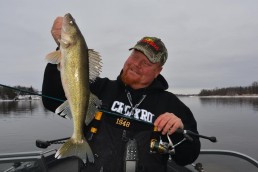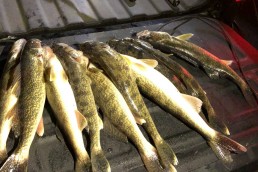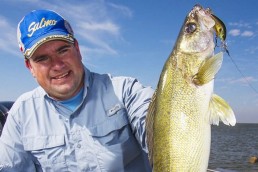Early-season Walleyes Spur Opening Day Excitement
SHARE THIS POST
States where the walleye season never closes don’t get to experience the kind of excitement we have during the walleye opener in Minnesota. About a million anglers hit the water on the opener each year, eager for tight lines following a long winter. Each opener is different and depends on how early or late the ice-out is on lakes, how the weather changes when the ice finally goes out and when the season exactly opens.
Lakes and rivers that don’t freeze in winter will have walleyes spawning as soon as water temperatures increase in April. Virtually all high-end sonars have surface temperature gauges, which give anglers a huge clue as to which species will be doing what year ’round.
If surface water temperatures are still in the upper 40s when the season opens, walleyes should still be close to their spawning areas and perhaps just finishing up their ritual. These fish are capable of spawning in rivers and lakes as long as they can find clean gravel with current or constant wave action at just the right depth.
Most lakes connected to a large river will have the walleye population split between river- spawning walleyes and lake spawning. An example is Cass Lake, which has walleyes spawning up the Mississippi River, up the Turtle River and then up several smaller streams, while other groups of this species remain in Cass Lake and Pike’s Bay to spawn along the rocky shorelines.
Some larger lakes can have a surprisingly small amount of suitable spawning habitat that gives these walleyes the perfect conditions they need to spawn successfully. They prefer to spawn in rivers if there’s ideal habitat. The number of walleyes using an area is also directly related to how successful the spawn was there in preceding seasons.
In order for more fish to return to a specific spawning area, the walleyes have to be successful, otherwise, the population of these fish that spawn in that particular spot will diminish over time.
Rivers warm up faster than lakes, so river-spawning ‘eyes are usually done with this phenomenon sooner than the ones that stay in the lakes to spawn. The walleyes in northern lakes and rivers typically spawn between 44 and 48 degrees, while these fish in the South spawn in 50-degree waters.
Male walleyes recover quicker than females after the spawn, and usually resume normal feeding within days. The females may take a week or two to recover and often rest in deeper waters or in heavy cover until they are ready to resume normal feeding. Once the females have recovered they show up in the shallows hungry and ready.
Anglers fishing walleyes early in a season usually target the post-spawn males. You need to anticipate the track that’s likely the one walleyes will take after the spawn back to their home lake. The obvious areas are inlets and outlets that walleyes have to pass through to get back to where they want to spend late spring and summer. Most tend to choose the deepest, largest lake in a chain of lakes as their home lake during the warmer months.
Walleyes will stage during the day on the outlet sides of lakes they’re passing through, waiting until dark before going through the shallower sections of a river section between the lakes. Males often stop to feed along their post-spawn migrations where they find a concentration of baitfish. These areas may be good for a week or two after the spawn. Typically, the only type of cover available to baitfish early in the season is new weed growth or areas with broken rock. Both are capable of holding schools of baitfish in spring, which will attract these migrating fish.
Are you enjoying this post?
You can be among the first to get the latest info on where to go, what to use and how to use it!
I like to scan the flats using side imaging on a Humminbird Helix 10 G2N SI. I’ll mark the spots I like best, then I’ll go back around and fish the key areas.
Spottail shiners are the main forage for walleyes in April and beyond, but other parts of the region and country may have emerald shiners, herring, smelt, alewives or some other type of larger forage that is the key to walleye location.
A jig and minnow is the all-time leader in number of walleyes caught during a post-spawn transition to the early summer period. I also use a long-shank jig like the Northland RZ Jig in the spring. I’ll rig a minnow by inserting the hook point in its mouth, out the gill, through the belly and then out the back. When the minnow is hooked right, it looks like a swimbait and travels through the water straight, without too much spin. The slightly exposed hook tip makes it a little more weedless than a minnow hooked up through the head. The placement of the hook farther back on the minnow also helps catch short-hitting walleyes.
Some areas may not have access to good live bait, and will have larger walleyes. If so, swimbaits will work. Also, I use a St. Croix Legend Elite medium-light rod for lighter jigs, and then go to a shorter Legend Elite medium-action rod when using paddle tail jigs. These are also good on windy days because the gusts can catch a rod tip, making it harder to feel the bites.
The cadence anglers use while jigging can make a huge difference in the number of bites they get. Guiding clients often stare at me while I’m fishing to see what I’m doing to get more bites.
Many of the patterns walleyes go through after the spawn will repeat again in the fall as lakes and rivers go through similar temperature swings and changes. Many of those same spots that produced in spring are likely to attract walleyes in fall, at least until they drop into deep waters as late fall proceeds toward winter.
During colder springs, the post-spawn walleye dispersal slows and fish may linger near their rocky spawning areas when the fishing season opens. Fish may also tend to be quite shallow atop flats.
During warmer springs, walleyes might disperse more quickly from spawning areas and toward weeds, rock or sand structure in the main-lake location. Deeper vertical jigging or live-bait rigging can be hot tactics.
MWO
SHARE THIS POST
Did you enjoy this post?
You can be among the first to get the latest info on where to go, what to use and how to use it!
Brian 'Bro' Brosdahl
Outdoor communicator Brian “Bro” Brosdahl lives in northern Minnesota. He is a walleye guide in the Cass Lake, Leech Lake and Lake Winnibigoshish areas. He is sponsored by Northland Fishing Tackle, Frabill/Plano, Aqua-Vu, Humminbird/Minn Kota, St. Croix Rods, Ranger Boats, and Evinrude. Guide inquiries: brosguideservice.com. Follow on social media.



